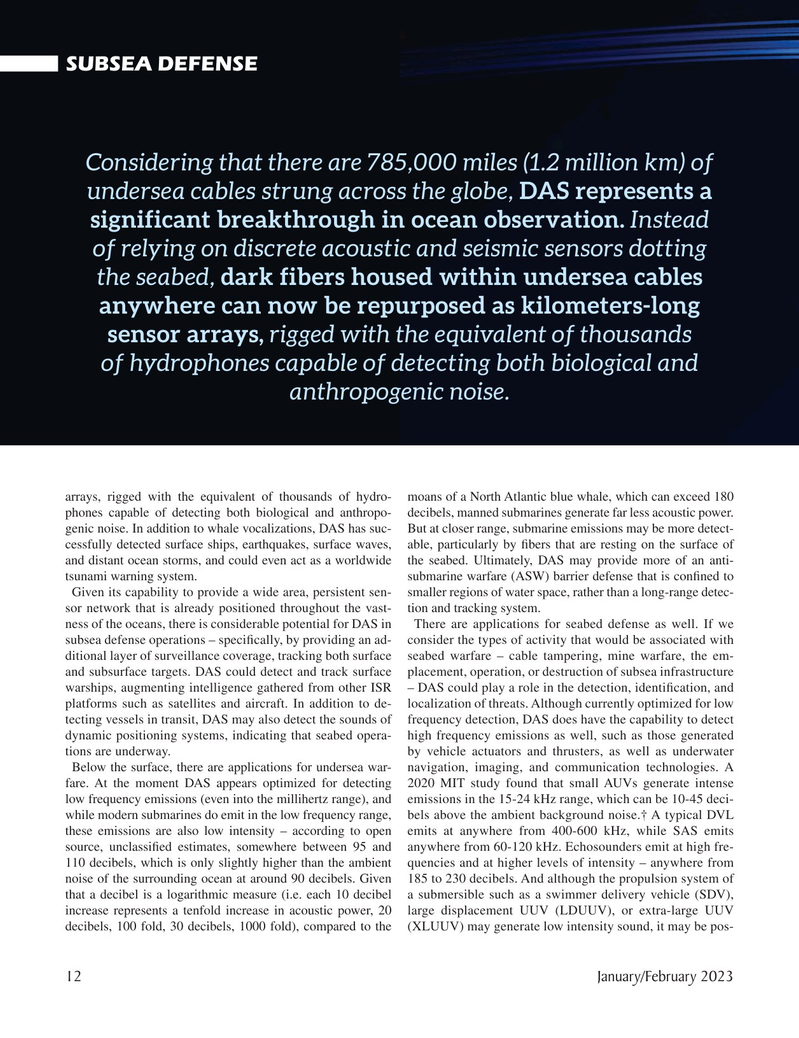
Page 12: of Marine Technology Magazine (January 2023)
Read this page in Pdf, Flash or Html5 edition of January 2023 Marine Technology Magazine
SUBSEA DEFENSE
Considering that there are 785,000 miles (1.2 million km) of undersea cables strung across the globe, DAS represents a significant breakthrough in ocean observation. Instead of relying on discrete acoustic and seismic sensors dotting the seabed, dark fibers housed within undersea cables anywhere can now be repurposed as kilometers-long sensor arrays, rigged with the equivalent of thousands of hydrophones capable of detecting both biological and anthropogenic noise.
arrays, rigged with the equivalent of thousands of hydro- moans of a North Atlantic blue whale, which can exceed 180 phones capable of detecting both biological and anthropo- decibels, manned submarines generate far less acoustic power. genic noise. In addition to whale vocalizations, DAS has suc- But at closer range, submarine emissions may be more detect- cessfully detected surface ships, earthquakes, surface waves, able, particularly by ? bers that are resting on the surface of and distant ocean storms, and could even act as a worldwide the seabed. Ultimately, DAS may provide more of an anti- tsunami warning system. submarine warfare (ASW) barrier defense that is con? ned to
Given its capability to provide a wide area, persistent sen- smaller regions of water space, rather than a long-range detec- sor network that is already positioned throughout the vast- tion and tracking system.
ness of the oceans, there is considerable potential for DAS in There are applications for seabed defense as well. If we subsea defense operations – speci? cally, by providing an ad- consider the types of activity that would be associated with ditional layer of surveillance coverage, tracking both surface seabed warfare – cable tampering, mine warfare, the em- and subsurface targets. DAS could detect and track surface placement, operation, or destruction of subsea infrastructure warships, augmenting intelligence gathered from other ISR – DAS could play a role in the detection, identi? cation, and platforms such as satellites and aircraft. In addition to de- localization of threats. Although currently optimized for low tecting vessels in transit, DAS may also detect the sounds of frequency detection, DAS does have the capability to detect dynamic positioning systems, indicating that seabed opera- high frequency emissions as well, such as those generated tions are underway. by vehicle actuators and thrusters, as well as underwater
Below the surface, there are applications for undersea war- navigation, imaging, and communication technologies. A fare. At the moment DAS appears optimized for detecting 2020 MIT study found that small AUVs generate intense low frequency emissions (even into the millihertz range), and emissions in the 15-24 kHz range, which can be 10-45 deci- while modern submarines do emit in the low frequency range, bels above the ambient background noise.† A typical DVL these emissions are also low intensity – according to open emits at anywhere from 400-600 kHz, while SAS emits source, unclassi? ed estimates, somewhere between 95 and anywhere from 60-120 kHz. Echosounders emit at high fre- 110 decibels, which is only slightly higher than the ambient quencies and at higher levels of intensity – anywhere from noise of the surrounding ocean at around 90 decibels. Given 185 to 230 decibels. And although the propulsion system of that a decibel is a logarithmic measure (i.e. each 10 decibel a submersible such as a swimmer delivery vehicle (SDV), increase represents a tenfold increase in acoustic power, 20 large displacement UUV (LDUUV), or extra-large UUV decibels, 100 fold, 30 decibels, 1000 fold), compared to the (XLUUV) may generate low intensity sound, it may be pos- 12 January/February 2023
MTR #1 (1-17).indd 12 1/22/2023 8:34:02 PM

 11
11

 13
13
